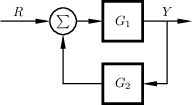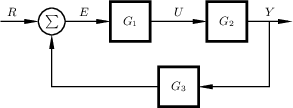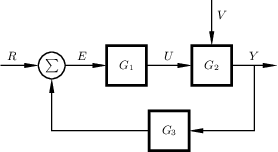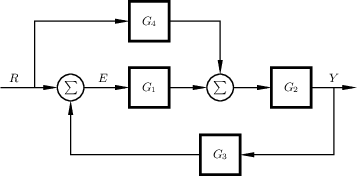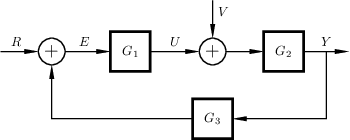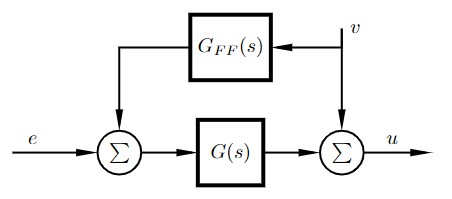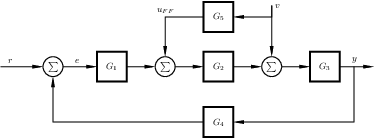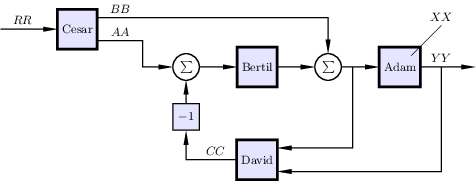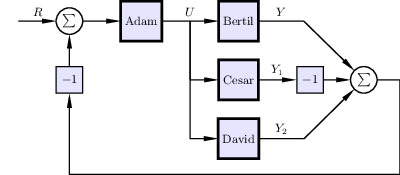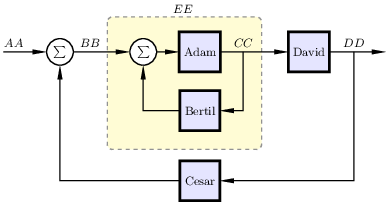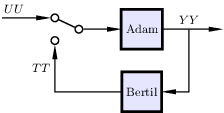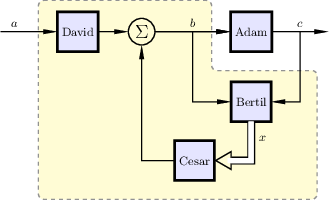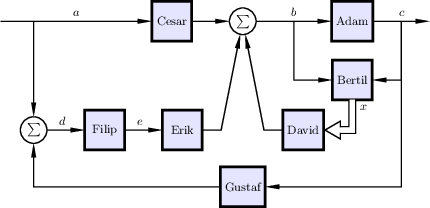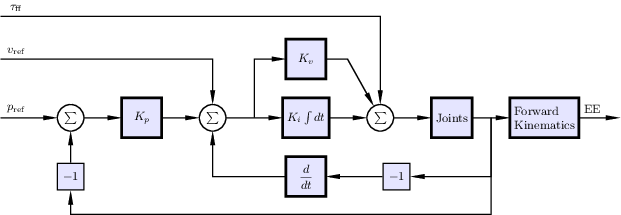|
Size: 21260
Comment:
|
← Revision 81 as of 2020-07-07 10:00:45 ⇥
Size: 6542
Comment:
|
| Deletions are marked like this. | Additions are marked like this. |
| Line 1: | Line 1: |
| ## page was renamed from Computer/Latex/BlockDiagrams ## page was renamed from BlockDiagrams |
|
| Line 3: | Line 5: |
| #acl Known:read,write,admin,delete,revert All:read |
|
| Line 4: | Line 8: |
{{{#!wiki caution '''Under Construction''' This warning will be removed once all [[computerBlockDiagram|Anton's eps block diagrams]] have been ported to [[http://www.ctan.org/pkg/pgf|TikZ]]. Feel free to contribute. (The existing block diagrams on this page cover all features needed to produce the port the remaining once.) }}} |
|
| Line 13: | Line 9: |
| [[https://www.control.lth.se/Staff/AntonCervin.html|Anton]] created a [[computerBlockDiagram|set of block diagrams]] in ps format, where text elements can be changed using {{{\psfrag}}} in LaTeX. This page provides ports of these block diagrams to TikZ. The reason for creating these ports were: * The traditional LaTeX compilation, using dvi and ps as middle formats, is widely being replaced with pdflatex and there is no equivalent to psfrag in pdflatex. |
* The traditional LaTeX compilation, using dvi and ps as middle formats, is widely being replaced with pdflatex and there is no equivalent to psfrag in pdflatex. Therefore eps figures and psfrag should be avoided. |
| Line 27: | Line 22: |
| \usetikzlibrary{shapes,positioning} \usetikzlibrary{narrow} |
\usetikzlibrary{shapes,positioning,narrow} \tikzset{block/.style={draw,rectangle,line width=1.4pt,minimum height=2.6em,minimum width=3em,outer sep=0pt,inner xsep=8pt,inner ysep=4pt}} \tikzset{sumcircle/.style={draw,circle,line width=1.4pt,outer sep=0pt,label=center:{$\sum$},minimum width=2em}} |
| Line 35: | Line 31: |
| \begin{tikzpicture}[auto, line width=1pt, >=narrow] \tikzset{block/.style={draw, rectangle, line width=2pt, minimum height=3em, minimum width=3em, outer sep=0pt}} \tikzset{sumcircle/.style={draw, circle, outer sep=0pt, label=center:{$\sum$}, minimum width=2em}} |
\begin{tikzpicture}{auto,line width=0.7pt,>=narrow} |
| Line 77: | Line 70: |
| The arrow style {{{>=narrow}}} is local to the department. If you do not have access to it on your computer, you may use {{{>=latex}}} instead, or download the file defining the style; [[attachment:Matlab2tikz/tikzlibrarynarrow.code.tex| |&do=get]]. | The arrow style {{{>=narrow}}} is local to the department. If you do not have access to it on your computer, you may use {{{>=latex}}} instead, or download the file defining the style; [[attachment:Matlab2tikz/tikzlibrarynarrow.code.tex| |&do=get]] (or http://dist.control.lth.se/public/Texlive/texmf-local/tex/latex/tikzlibrarynarrow.code.tex ). |
| Line 92: | Line 85: |
| {{{ \begin{tikzpicture}[scale=0.6, transform shape] }}} The above scales everything. |
|
| Line 100: | Line 98: |
| The figures below are links to separate pages with complete source code and some relevant comments for each figure. (They will be, it is still work in progress /Leif) | |
| Line 110: | Line 109: |
| {{attachment:feedback1b.png}} {{{ \documentclass{standalone} \usepackage{tikz} \usetikzlibrary{shapes, positioning} \usetikzlibrary{narrow} \begin{document} \begin{tikzpicture}[auto, line width=1pt, >=narrow] \tikzset{block/.style={draw, rectangle, line width=2pt, minimum height=3em, minimum width=3em, outer sep=0pt}} \tikzset{sumcircle/.style={draw, circle, outer sep=0pt, label=center:{$\sum$}, minimum width=2em}} |
[[/feedback1b_tikz|{{attachment:feedback1b.png}}]] |
| Line 121: | Line 111: |
| \node[block](G1){$G_1$}; \node[block,right=12mm of G1](G2){$G_2$}; \draw[->](G1)--node[above](U){$U$}(G2); \node[block,below=12mm of U](G3){$G_3$}; \node[sumcircle,left=11mm of G1](sum){}; \node[coordinate, left=10mm of sum](ref){}; \node[coordinate, above=12mm of G2](dist){}; \draw[->](ref)--node[xshift=-2mm](){$R$}(sum); \draw[->](sum)--node[xshift=-1mm](){$E$}(G1); \node[coordinate, right=12mm of G2](output){}; \draw[->](G2)--node[xshift=0mm](Y){$Y$}(output); \draw[->](Y)|-(G3); \draw[->](G3)-|(sum); \draw[->](dist)--node[yshift=2mm](){$V$}(G2); \end{tikzpicture} \end{document} }}} |
|
| Line 141: | Line 114: |
| {{attachment:feedback1d.png}} {{{ \documentclass{standalone} \usepackage{tikz} \usetikzlibrary{shapes,positioning} \usetikzlibrary{narrow} \begin{document} \begin{tikzpicture}[auto, line width=1pt, >=narrow] \tikzset{block/.style={draw, rectangle, line width=2pt, minimum height=3em, minimum width=3em, outer sep=0pt}} \tikzset{sumcircle/.style={draw, circle, outer sep=0pt, label=center:{$\sum$}, minimum width=2em}} \node[block](G1){$G_1$}; \node[block,above=7 mm of G1](G4){$G_4$}; \node[sumcircle,right=10mm of G1](sum2){}; \node[block,right=10mm of sum2](G2){$G_2$}; \node[block,below=9mm of sum2](G3){$G_3$}; \node[sumcircle,left=12mm of G1](sum){}; \node[coordinate, left=15mm of sum](ref){}; \node[coordinate, left=6mm of sum](fork){}; \draw[->](ref)--node[xshift=-4mm](){$R$}(sum); \draw[->](sum)--node[xshift=-1mm](){$E$}(G1); \draw[->](G1)--(sum2); \draw[->](sum2)--(G2); \draw[->](fork)|-(G4); \draw[->](G4)-|(sum2); \node[coordinate, right=12mm of G2](output){}; \draw[->](G2)--node[xshift=0mm](Y){$Y$}(output); \draw[->](Y)|-(G3); \draw[->](G3)-|(sum); \end{tikzpicture} \end{document} }}} ==== feedback1e ==== |
[[/feedback1d_tikz|{{attachment:feedback1d.png}}]] |
| Line 177: | Line 117: |
| {{attachment:feedback2.png}} In this example the summation circles have a different character in them. It is of course simple to change to e.g. the one used previously, or to change the previous examples to use this summation circle style. {{{ \documentclass{standalone} \usepackage{tikz} \usetikzlibrary{shapes,positioning} \usetikzlibrary{narrow} \begin{document} \begin{tikzpicture}[auto, line width=1pt, >=narrow] \tikzset{block/.style={draw, rectangle, line width=2pt, minimum height=3em, minimum width=3em, outer sep=0pt}} \tikzset{sumcircle/.style={draw, circle, outer sep=0pt, label=center:{{\Large$+$}}, minimum width=2em}} \node[block](G1){$G_1$}; \node[sumcircle,right=13mm of G1](sum2){}; \node[block,right=10mm of sum2](G2){$G_2$}; \node[block,below=9mm of sum2](G3){$G_3$}; \node[sumcircle,left=12mm of G1](sum){}; \node[coordinate, left=10mm of sum](ref){}; \node[coordinate, right=12mm of G2](output){}; \node[coordinate, above=10mm of sum2](dist){}; \draw[->](ref)--node[xshift=-1mm](){$R$}(sum); \draw[->](sum)--node[xshift=-1mm](){$E$}(G1); \draw[->](G1)--node(){$U$}(sum2); \draw[->](sum2)--(G2); \draw[->](dist)--node[yshift=2mm](){$V$}(sum2); \draw[->](G2)--node[xshift=0mm](Y){$Y$}(output); \draw[->](Y)|-(G3); \draw[->](G3)-|(sum); \end{tikzpicture} \end{document}}}} ==== feedback3 ==== ==== feedback4 ==== ==== feedback5 ==== ==== feedback6 ==== ==== feedback7 ==== ==== feedback8 ==== ==== feedback9 ==== ==== feedback10 ==== ==== feedback11 ==== |
[[/feedback2_tikz|{{attachment:feedback2.png}}]] |
| Line 229: | Line 122: |
| [[/cascade1_tikz|{{attachment:cascade1.png}}]] | |
| Line 234: | Line 128: |
| ==== ff0 ==== [[/ff0_tikz|{{attachment:ff0.png}}]] |
|
| Line 237: | Line 134: |
| [[/fbff2_tex|{{attachment:fbff2.png}}]] | |
| Line 246: | Line 144: |
| {{attachment:smith1.png}} {{{ \documentclass{standalone} \usepackage{tikz} \usetikzlibrary{shapes,positioning,calc} \usetikzlibrary{narrow} \begin{document} \begin{tikzpicture}[auto, line width=1pt, >=narrow, x=1mm,y=1mm] \tikzset{block/.style={draw, rectangle, line width=2pt, fill=blue!10, minimum height=3em, minimum width=3em, outer sep=0pt}} \tikzset{blockMinus/.style={draw,minimum width=2em, minimum height=2em,line width=1pt,fill=blue!10,label=center:{$-1$} }} \tikzset{sumcircle/.style={draw, circle, outer sep=0pt, label=center:{{$\sum$}}, minimum width=2em}} \node[block](Adam){Adam}; \node[sumcircle, left=10mm of Adam](sumA){}; \coordinate[left=10 mm of sumA](input){}; \node[block, right=15 mm of Adam](Bertil){Bertil}; \node[block, below=5 mm of Bertil](Cesar){Cesar}; \node[block, below=5 mm of Cesar](David){David}; \node[blockMinus, right=10mm of Cesar](minusA){}; \node[blockMinus](minusB) at ($(Cesar-|sumA)$){}; \node[sumcircle, right=7mm of minusA](sumB){}; \coordinate[right=12mm of Bertil](Bertil1){}; \coordinate[right=12mm of David](David1){}; \coordinate[right=6mm of sumB](out); \coordinate[below=25mm of out](out2); \draw[->](input)--node(){$R$}(sumA); \draw[->](sumA)--(Adam); \draw[->](Adam)--node(U){$U$}(Bertil); \draw[->](U)|-(Cesar); \draw[->](U)|-(David); \draw[->](Bertil)--node(){$Y$}(Bertil1)--(sumB); \draw[->](Cesar)--node(){$Y_1$}(minusA); \draw[->](minusA)--(sumB); \draw[->](David)--node(){$Y_2$}(David1)--(sumB); \draw[->](sumB)--(out)--(out2)-|(minusB); \draw[->](minusB)--(sumA); \end{tikzpicture} \end{document} }}} |
[[/smith1_tikz|{{attachment:smith1.png}}]] |
| Line 288: | Line 147: |
| [[attachment:smith2.pdf|{{attachment:smith2.png}}|target=blank_]] {{{ \begin{tikzpicture} \small \tikzstyle{block} = [draw,rectangle,minimum size=8mm,node distance=25mm] \tikzstyle{sum} = [draw, circle,node distance=8mm,inner sep=0mm,minimum size=4mm] \node[sum](s1){$s$}; \node[coordinate,left of=s1](input){}; \draw[->](input)--node[above,near start](){$R$}(s1); \node[sum,right of=s1,xshift=8mm](s2){$s$}; \draw[->](s1)--node[above,near start](){$E$}(s2); \node[block,right of=s2,xshift=-14mm](G1){$G_1$}; \draw[->](s2)--(G1); \node[block,below of=G1,yshift=12mm](G3){$G_3$}; \draw[->](G3)-|(s2); \node[block,right of=G1,xshift=-4mm](G2){$G_2$}; \draw[->](G1)--node[above,xshift=-2mm](){$U$}(G2); \draw[->]([xshift=4mm]G1.east)|-(G3); \draw[dashed]([xshift=-18mm,yshift=-6mm]G3) rectangle ([xshift=12mm,yshift=6mm]G1); \node[rectangle,above of=G1,xshift=-4mm,yshift=-2mm](){$C$}; \node[coordinate,right of=G2,xshift=2mm](output){}; \draw[->](G2)--node[above,near end](){$Y$}(output); \node[block,below of=G3,yshift=10mm](G4){$G_4$}; \draw[->](G4)-|(s1); \draw[->]([xshift=2mm]G2.east)|-(G4); \end{tikzpicture} }}} |
[[/smith2_tikz|{{attachment:smith2.png}}]] |
| Line 318: | Line 151: |
| ==== parallel ==== | |
| Line 321: | Line 153: |
| [[attachment:nyquist.pdf|{{attachment:nyquist.png}}|target=blank_]] {{{ \begin{tikzpicture} \small \tikzstyle{block}=[draw,rectangle,minimum size=8mm] \tikzstyle{connector}=[draw,circle,node distance=8mm,inner sep=0mm,minimum size=2mm] \node[block](G2){$G_2$}; \node[draw,rectangle,below of=G2,yshift=-2mm](G3){$G_3$}; \node[coordinate,right of=G2,xshift=4mm](output){}; \draw[->](G2)--node[above,near end](){$Y$}(output); \draw[->]([xshift=4mm]G2.east)|-(G3); \node[connector,left of=G2,xshift=-4mm](o1){}; \draw[->](o1)--(G2); \node[connector,left of=o1,xshift=2mm,yshift=2mm](i1){}; \node[connector,left of=o1,xshift=2mm,yshift=-2mm](i2){}; \draw[-](i1)--(o1); \draw[-](G3)-|node[left,very near end](){$T$}(i2); \node[coordinate,left of=i1](input){}; \draw[-](input)--node[above,near start](){$U$}(i1); \end{tikzpicture} }}} ==== openloop1 ==== ==== openloop1b ==== ==== openloop2 ==== ==== openloop2c ==== ==== dist1 ==== ==== dist2 ==== ==== dist3 ==== |
[[/nyquist_tikz|{{attachment:nyquist.png}}]] |
| Line 360: | Line 158: |
| [[attachment:statefeed1.pdf|{{attachment:statefeed1.png}}|target=blank_]] {{{ \begin{tikzpicture} \small \tikzstyle{block}=[draw,rectangle,minimum size=8mm] \tikzstyle{sum} = [draw, circle,node distance=8mm,inner sep=0mm,minimum size=4mm] \tikzset{doublearrow/.style={draw,thin,double distance=2pt,->,>=stealth}} \node[block](r){$r$}; \node[coordinate,left of=r,xshift=-2mm](input){$d$}; \draw[->](input)--node[above,near start](){$d$}(r); \node[sum,right of=r,xshift=4mm](s1){$s$}; \draw[->](r)--(s1); \node[block,right of=s1,xshift=12mm](P){$P$}; \draw[->](s1)--node[above,near start](){$b$}(P); \node[coordinate,right of=P,xshift=4mm](output){}; \draw[->](P)--node[above,near end](){$c$}(output); \node[block,below of=P,xshift=-10mm,yshift=-4mm](f){$f$}; \path[doublearrow](P)|-(f); \draw[->](f)-|(s1); \end{tikzpicture} }}} |
[[/statefeed1_tikz|{{attachment:statefeed1.png}}]] |
| Line 385: | Line 163: |
| [[/statefeed4_tikz|{{attachment:statefeed4.png}}]] | |
| Line 387: | Line 166: |
| {{attachment:statefeed5.png}} | [[/statefeed5_tikz|{{attachment:statefeed5.png}}]] |
| Line 389: | Line 168: |
| The bluish background color of the boxes and also the yellow backgrond are of course only examples and are easily changed to something else. | |
| Line 391: | Line 169: |
| {{{ \documentclass{standalone} \usepackage{tikz} \usetikzlibrary{shapes,positioning,calc} \usetikzlibrary{narrow} % The double arrow comes from % http://www.texample.net/tikz/examples/double-arrows/ % with modification in % http://tex.stackexchange.com/questions/169061/tikz-increase-arrow-head-size \usetikzlibrary{arrows,decorations.markings} % Handle the yellow background \pgfdeclarelayer{background} \pgfdeclarelayer{foreground} \pgfsetlayers{background,main,foreground} \begin{document} \begin{tikzpicture}[auto, line width=1pt, >=narrow, x=1mm,y=1mm] \tikzset{block/.style={draw, rectangle, line width=2pt, fill=blue!10, minimum height=3em, minimum width=3em, outer sep=0pt}} \tikzset{sumcircle/.style={draw, circle, outer sep=0pt, label=center:{{\Large$\Sigma$}}, minimum width=2em}} \tikzset{vecArrow/.style={ line width=1pt, decoration={ markings,mark=at position 1 with { \arrow[scale=2.5,line width=0.4pt] {open triangle 60} } }, double distance=4pt, shorten >= 13pt, preaction = {decorate}, postaction = {draw,line width=4pt, white,shorten >= 10pt} }} \tikzset{innerWhite/.style={semithick, white, line width=1.4pt, shorten >= 4.5pt}} \node[sumcircle](sumA){}; \node[block, right=20mm of sumA](Adam){Adam}; \coordinate[right=15mm of Adam](output); \node[block,below=8mm of Adam](Bertil){Bertil}; \node[block,below=5mm of Bertil,xshift=-15mm](Cesar){Cesar}; \node[block,left=8mm of sumA](David){David}; \coordinate[left=15mm of David](input); \draw[->](input)--node[xshift=-4mm]{$a$}(David); \draw[->](David)--(sumA); \draw[->](sumA)--(Adam); \draw[->](sumA)--node(forkB){$b$}(Adam); \draw[->](Adam)--node(forkC){$c$}(output); \draw[->](forkC)|-(Bertil); \draw[->](forkB)|-(Bertil); \draw[vecArrow](Bertil)|-node[xshift=3mm,yshift=8mm]{$x$}(Cesar); \draw[->](Cesar)-|(sumA); \begin{pgfonlayer}{background} \coordinate(a1) at ($(David.west |- David.north) + (-5,3)$); \coordinate(a2) at ($(Adam.west|-a1) + (-5,0)$); \coordinate (a3) at ($(a2|-Adam.south) + (0,-5)$); \coordinate (a4) at ($(a3 -| Adam.east) + (12,0)$); \coordinate (a5) at ($(a4|-Cesar.south) + (0,-5)$); \coordinate(a6) at (a5-|a1); \path[fill=yellow!20,rounded corners, draw=black!50, dashed] (a1)--(a2)--(a3) -- (a4) --(a5) -- (a6)-- cycle; \end{pgfonlayer} \end{tikzpicture} \end{document} }}} |
|
| Line 457: | Line 171: |
| {{attachment:statefeed6.png}} {{{ \documentclass{standalone} \usepackage{tikz} \usetikzlibrary{shapes,positioning} \usetikzlibrary{narrow} \usetikzlibrary{arrows,decorations.markings} |
[[/statefeed6_tikz|{{attachment:statefeed6.png}}]] |
| Line 465: | Line 173: |
| \begin{document} \begin{tikzpicture}[auto, line width=1pt, >=narrow] \tikzset{block/.style={draw, rectangle, line width=2pt,fill=blue!10, minimum height=3em, minimum width=3em, outer sep=0pt}} \tikzset{sumcircle/.style={draw, circle, outer sep=0pt, minimum width=3em, label=center:{{$\displaystyle\sum$} } }} \tikzset{vecArrow/.style={ line width=1pt, decoration={ markings,mark=at position 1 with {\arrow[scale=2.5,line width=0.4pt] {open triangle 60} }}, double distance=4pt, shorten >= 13pt, preaction = {decorate}, postaction = {draw,line width=4pt, white,shorten >= 10pt} } } \tikzset{innerWhite/.style={semithick, white, line width=1.4pt, shorten >= 4.5pt}} \node[sumcircle](sumA){}; \node[block,right=20mm of sumA](Adam){Adam}; \coordinate[right=15mm of Adam](output); \node[block,below=5mm of Adam](Bertil){Bertil}; \node[block,left=10mm of sumA](Cesar){Cesar}; \node[block, below=20mm of sumA,xshift=16mm](David){David}; \node[block, below=20mm of sumA,xshift=-16mm](Erik){Erik}; \node[block, left=10mm of Erik](Filip){Filip}; \node[sumcircle, left=10mm of Filip](sumB){}; \node[block,below=35mm of sumA](Gustaf){Gustaf}; %\path let \p1=(sumB) \coordinate[left=40mm of Cesar](Input){}; \draw[->](Input)--node{$a$}(Cesar); \draw[->](Cesar-|sumB)--(sumB); \draw[->](sumB)--node[xshift=-1mm]{$d$}(Filip); \draw[->](Filip)--node[xshift=-1mm]{$e$}(Erik); \draw[->](Cesar)--(sumA); \draw[->](sumA)--node(forkB){$b$}(Adam); \draw[->](forkB)|-(Bertil); \draw[->](Adam)--node(C){$c$}(output); \draw[->](C)|-(Gustaf); \draw[->](C)|-(Bertil); \draw[->](Gustaf)-|(sumB); \draw[vecArrow](Bertil)|-node[xshift=3mm,yshift=8mm]{$x$}(David); \coordinate[right=5mm of Erik](ER); \draw[->](Erik)--(ER)--(sumA); \coordinate[left=5mm of David](DL); \draw[->](David)--(DL)--(sumA); \end{tikzpicture} \end{document} }}} |
|
| Line 509: | Line 175: |
| [[attachment:abbirb.pdf|{{attachment:abbirb.png}}|target=blank_]] {{{ \tikzstyle{block} = [draw, fill=white, rectangle, minimum height=2em, minimum width=4em, align=center] \tikzstyle{sum} = [draw, fill=white, circle] \tikzstyle{input} = [coordinate] %coordinate is used as helper \tikzstyle{output} = [coordinate] \tikzstyle{arrow} = [draw, ->] \def\radius{.9mm} \tikzstyle{s}=[shift={(\radius, 0mm)}] % The block diagram code is probably more verbose than necessary \begin{tikzpicture}[auto, node distance=1.7cm,>=latex'] % We start by placing the blocks \node [input, name=posref] {$q_{ref}$}; \node [input, above=1.2of posref, name=velref] {$\dot{q}_{ref}$}; \node [input, above=1.2of velref, name=trqffw] {$\tau_{ff}$}; \node [sum, right of=posref] (psum) {$\Sigma$}; \node [block, right of=psum] (kp) {$K_p$}; \node [sum, right of=kp] (vsum) {$\Sigma$}; \node [block, right of=vsum] (ki) {$K_i\int{dt}$}; \node [block, above of=ki] (kv) {$K_v$}; \node [sum, right of=ki] (tausum) {$\Sigma$}; \node [block, right of=tausum] (motor) {Joints}; \node [block, right=0.7of motor] (fk) {Forward\\ Kinematics}; \node [output, right=of fk] (output) {$T_S^E$}; \node [block, below of=ki] (pdiff) {$\frac{d}{dt}$}; % Once the nodes are placed, connecting them is easy. \draw [arrow] (posref) node [above right] {$p_{ref}$} -- (psum); \draw [arrow] (velref) node [above right] {$v_{ref}$} -| (vsum.north); \draw [arrow] (trqffw) node [above right] {$\tau_{ff}$} -| (tausum.north); \draw [arrow] (psum) -- node {} (kp); \draw [arrow] (kp) -- node {} (vsum); \draw [arrow] (vsum) -- node {} (ki); \draw [arrow] (ki) -- node {} (tausum); \draw [arrow] (tausum) -- node {} (motor); \draw [arrow] (motor) -- (fk); \draw [arrow] (fk) -- node {$T_{RB}^{TF}$} (output); \draw [arrow] ([xshift=3mm]motor.east) |- node {} (pdiff); \draw [arrow] (pdiff) -| node[pos=0.96, right] {$-$} (vsum.south); \draw [arrow] ([xshift=3mm]vsum.east) |- node [auto] {} (kv); \draw [arrow] (kv) -| node [auto] {} (tausum.north west); \path ([xshift=3mm, yshift=-9mm]motor.east) coordinate (branch); \draw[->] (branch) [shift only] -- ([s]branch -| vsum.south) arc(0:180:\radius) -| node[pos=0.96, right] {$-$} (psum.south); \end{tikzpicture} }}} |
[[/ABBirb_tikz|{{attachment:ABBirb.png}}]] |
Block diagrams in TikZ format
Background
- The traditional LaTeX compilation, using dvi and ps as middle formats, is widely being replaced with pdflatex and there is no equivalent to psfrag in pdflatex. Therefore eps figures and psfrag should be avoided.
- TikZ allows for changes not only of text, but also of the graphics, directly in the .tex document.
Matlab graphics can be exported to TikZ. The format can therefore cater for all graphics needs.
The TikZ code for many of the block diagrams on this page can be made prettier by using e.g. the TikZ calc package, and some additional thinking. Feel free to make improvements where you come across bad programming style. Some of you might also prefer stylistic changes (different line thickness, different aspects of the boxes, etc.), which are easy to introduce in TikZ. If you change the code, please also upload the corresponding pdf and a png copy of it.
Practical
A simple Example
TikZ is a programming language and a TikZ picture is a set of code. The below minimal example shows a .tex document, demonstrating the inclusion of a TikZ block diagram:
\documentclass{pm}
\usepackage{tikz}
\usetikzlibrary{shapes,positioning,narrow}
\tikzset{block/.style={draw,rectangle,line width=1.4pt,minimum height=2.6em,minimum width=3em,outer sep=0pt,inner xsep=8pt,inner ysep=4pt}}
\tikzset{sumcircle/.style={draw,circle,line width=1.4pt,outer sep=0pt,label=center:{$\sum$},minimum width=2em}}
\begin{document}
Figure~\ref{fig:blocks} shows an example block diagram.
\begin{figure}
\centering
%
\begin{tikzpicture}{auto,line width=0.7pt,>=narrow}
\node[block](G1){$G_1$};
\node[block,below=6mm of G1](G2){$G_2$};
\node[sumcircle,left=7mm of G1](sum){};
\node[coordinate,left=13mm of sum](input){};
\node[coordinate,right=13mm of G1](output){};
\draw[->](input)--node[xshift=-2mm]{$R$}(sum);
\draw[->](sum)--(G1);
\draw[->](G1)--node(y)[]{$Y$}(output);
\draw[->](y)|-(G2){};
\draw[->](G2)-|(sum);
\end{tikzpicture}
\caption{This is a block diagram.\label{fig:blocks}}
\end{figure}
\end{document}The above code generates a picture that looks like this:
If you think the TikZ code (\begin{tikzpicture to \end{tikzpicture}) clutters the .tex file, it can be placed in a separate file, e,g. mypicture.tikz, and inserted in the .tex file using the the command \input{mypicture.tikz}, which simply places the content of mypicture.tikz at the location of the command.
A further improvement is to use the standalone class and package to create the pictures and to insert them into the main document. All block diagram examples below are created with the standalone class, and the main document to include them would be (same example as above):
\documentclass{pm}
\usepackage{standalone}
\usepackage{tikz}
\usetikzlibrary{shapes,positioning}
\usetikzlibrary{narrow}
\begin{document}
Figure~\ref{fig:blocks} shows an example block diagram.
\begin{figure}
\centering
\input{feedback0.tikz}
\end{figure}
\end{document}The arrow style >=narrow is local to the department. If you do not have access to it on your computer, you may use >=latex instead, or download the file defining the style; Matlab2tikz/tikzlibrarynarrow.code.tex (or http://dist.control.lth.se/public/Texlive/texmf-local/tex/latex/tikzlibrarynarrow.code.tex ).
Scaling the block diagrams
A simple way to change the size, when including a TikZ picture is to add an extra argument to \begin{tikzpicture}. Here are some examples:
\begin{tikzpicture}[scale=0.6]The above scales edges, but not the nodes, neither text.
\begin{tikzpicture}[scale=0.6, every node/.style={scale=0.6}]The above scales both nodes and edges, but not text.
\begin{tikzpicture}[scale=0.6, transform shape]The above scales everything.
Some people think the default line width is a bit thin. This can easily be changed by adding e.g. thick to the argument list; \begin{tikzpicture}[thick]. (Arguments are comma-separated.)
More info
A lot can be found on online forums. There also exists an extremely well-written (but long!) manual for TikZ and a much more compact minimal introduction.
Note that you can draw almost anything in TikZ, not only block diagrams.
Block diagrams
The figures below are links to separate pages with complete source code and some relevant comments for each figure. (They will be, it is still work in progress /Leif)
Feedback systems
feedback0
feedback1
feedback1b
feedback1c
feedback1d
feedback2
Other regulator structures
cascade1
cascade2
cascadeff
ff0
fbff1
fbff2
fftf
ffss
2DOF
smith1
smith2
Miscellaneous other
nyquist
State feedback and observers
statefeed1
statefeed2
statefeed4
statefeed5
statefeed6


